Why being organized at work can make you, and your team, better employees
You know that being organized can help you keep things tidy, but did you know it can help impact your job performance—and your happiness at the office? According to one survey led by OfficeMax, 90 percent of Americans believe clutter has a negative impact on their lives and work, and 77 percent believe clutter damages their productivity. And the inverse is true too: tidiness appears to positively influence work life. According to a 2013 study, people exposed to a neat work environment persisted at a task for more than 1.5 times as long as those who were exposed to a messy space.
Are you and your employees wasting precious work time because your environment isn’t setting you up for success? Here are some ways to help stay organized and ahead of the game at work:
Keep your desk clean. Having a clutter-free desk is a no-brainer for staying organized at work. Instead of hanging on to conference brochures and old presentations for dear life, file away or say goodbye. Since desk surfaces are known to average a whopping 100 times more bacteria than a kitchen table and 400 times more bacteria than a toilet seat(!), it’s safe to say that you’ll benefit from having a clean and organized workstation.
Folders are your friend. Digital and paper folders are key to keeping yourself in check. Instead of wasting your day searching for that one email you swear you were just reading, create folders that are easy to identify and navigate. If you mostly work via email, make it a goal to organize every email into an appropriate e-file. If you opt for paper too, have a handy filing cabinet close to your desk with colorful labels to help you know what goes where.
Use a checklist: Nothing is more satisfying than checking off a box from your long work to-do list. To keep yourself honest, and organized, refer to a daily checklist to help you understand what your daily goals are, and the priorities that go along with them. You’ll have a better understanding of what you need to accomplish each day, and a greater sense of accomplishment when you can scratch an item off your list.
Use project plans: When you’re kicking off a project, start things off the simple way. Always start with a project plan that you can share with your team and continue to reference along the way. Specify deadlines, goals, and stakeholders to give you and your teammates a clear understanding of what needs to be accomplished and how you’ll get there. Create a project plan template that you can work off of for each project, and better yet, step up to the plate and share with your team so they can use it for their projects too.
Keep a calendar: These days, it’s fairly easy to get a hand on your day-to-day schedule thanks to digital calendars connected to your email. Always make sure that your calendar is up to date with meetings and appointments so you know what to expect for the day ahead. If you’re more of a visual person, try going back to a printed calendar or planner so you can write down your commitments and process what’s ahead.



